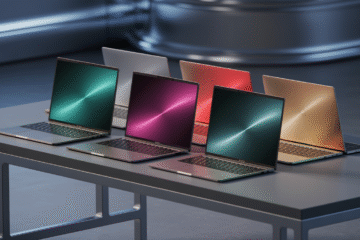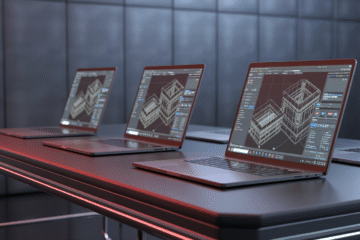Best MacBooks for Creators (2025)
For creators, a great MacBook isn’t just about raw horsepower—it’s about the flow of your day. Can you jump from Lightroom to Final Cut without hiccups? Can you color-grade at the café without a fan screaming? Does your battery survive a full shoot day of dumps, selects, and quick edits? This guide focuses on the creator experience—display quality, battery endurance under real workloads, silent thermals, and the little touches (like fast wake, media engine acceleration, and rock-solid standby) that keep you in the zone.
Below, we’ll break down what actually matters, then dive into four standout Apple laptops that suit different creative styles and budgets—ranked in the order you requested:
-
Apple MacBook Air 15-inch (2024) See on Amazon
-
Apple MacBook Air 15-inch (2025) See on Amazon
-
Apple MacBook Pro (2024) See on Amazon
-
Apple MacBook Air 13-inch (2025) See on Amazon
What Creators Should Prioritize (Beyond Spec Sheets)
The Display You Grade On
A creator’s screen is a tool, not a billboard. You want a bright, accurate panel with wide color coverage and minimal reflections. Apple’s recent Air and Pro displays offer excellent sharpness and consistency; the Pro’s XDR panel on supported models raises the ceiling for HDR mastering, while Air panels remain superb for SDR/photo work and on-the-go editing.
The Media Engine Advantage
Apple Silicon integrates dedicated hardware blocks for common codecs (H.264/H.265/HEVC and, on newer chips, AV1). For creators, that means smoother timelines and faster exports at lower power draw. You’ll feel it when scrubbing 4K or reviewing multicam proxies off battery.
RAM & Storage That Don’t Fight You
-
Memory: 16GB unified memory is the current baseline for creative comfort. Step to 24–32GB if you juggle big RAW batches, After Effects/Fusion comps, or heavy multicam timelines.
-
Storage: 1TB internal NVMe gives headroom for caches, libraries, and day-to-day projects. Pair with a fast Thunderbolt/USB-C NVMe SSD for active media and offloads.
Battery and Thermals for Real Work
MacBooks excel at staying quick off-charger. The difference shows up in a quiet room: exports roll, previews render, and you’re not hunting for an outlet. Fanless Air models add the superpower of silence, ideal for VO booths, interviews, and late-night edits.
Ports, Docking, and Workflow Fit
Newer models bring back HDMI and SD on the Pro line, while Air stays lean. In practice, a compact USB-C hub or Thunderbolt dock standardizes your desk and keeps cable sprawl under control.
4- Apple MacBook Air 15-Inch (2024)
Who It’s For
Photographers, YouTubers, and social-first editors who want a larger canvas without stepping into Pro pricing or weight. If your work is primarily SDR photo/video, scripting, motion graphics, light, and DAW recording with occasional 4K edits, this is a beautiful daily driver.
Creator Experience
-
Display & Canvas: The 15-inch panel gives you more timeline and tool palette space than the 13-inch, reducing UI crowding in Lightroom, Final Cut, and Resolve.
-
Silence: Fanless design means no noise during VO takes or on-set backups.
-
Battery: Realistically, all day for photo culling, script work, and proxy-based editing at moderate brightness.
-
Media Engine: Smooth decoding/encoding of mainstream codecs keeps playback responsive without spiking fans—because there aren’t any.
Best Workflows
-
Photo editing and batch exports in Lightroom/Photoshop (SDR).
-
4K proxy timelines in Final Cut/Resolve; shorts, reels, podcasts.
-
Writing, Notion, and color-accurate web publishing.
Recommended Config
-
Memory: 16GB (24GB if you run big RAW sets and many apps together).
-
Storage: 1TB internal + portable NVMe for live projects.
-
Accessories: USB-C SD reader, compact PD charger, and a color probe if you soft-proof regularly.
Considerations
Under sustained heavy renders, performance will level to protect thermals. For frequent long encodes, the Pro line is faster and steadier but many creators never hit those limits.
3- Apple MacBook Air 15-Inch (2025)
What’s New in Spirit
Think of the 2025 15-inch Air as an evolution of the 2024 model with incremental polish: slightly better efficiency, tighter integration across the stack, and modest uplift in media handling depending on exact chip tier. For creators, the feel improves: snappier wake, longer endurance at similar brightness, and smoother background tasks while you grade or composite lightly.
Creator Experience
-
Battery & Efficiency: Even more forgiving on long travel days, excellent for location shooters who live on power banks and hotel outlets.
-
Responsiveness: App switching under load feels crisp; exporting a batch of stills while scrubbing a short timeline is very doable.
-
Thermal Behavior: Still fanless and quiet; behavior is predictable, which is great for live recordings and small rooms.
Best Workflows
-
All of the 2024 Air use cases, with a bit more headroom: heavier Lightroom catalogs, longer proxy timelines, and larger After Effects templates (still not a Pro replacement for 3D or heavy FX).
Recommended Config
-
Memory: 16GB baseline; 24–32GB if you often keep Photoshop + Lightroom + an NLE + a browser full of references all open.
-
Storage: 1TB internal; keep a rugged 2TB USB-C NVMe for location work.
Considerations
Ports remain lean. If your desk setup involves multiple displays, fast card readers, and RAID storage, budget for a Thunderbolt dock. If you’re regularly delivering HDR or pushing dense multicam, see the Pro below.
2- Apple MacBook Pro (2024)
Who It’s For
Editors, colorists, VFX artists, audio pros, and 3D generalists who need sustained performance and a display capable of serious HDR work. If your weekdays are stacked with multicam interviews, heavy noise reduction, or After Effects/Fusion comps, this is the right tier.
Creator Experience
-
Display: Liquid Retina XDR (on supported models) elevates HDR grading and reference viewing beyond what an Air can do. SDR work also benefits from the uniform brightness and contrast.
-
Thermals & Fans: Under duration workloads, denoise, export, caching, simulation,s the Pro stays fast and composed. Fans spin, but the acoustic profile is controlled compared to many Windows workstations.
-
Media Engines & GPU: Bigger timelines feel “lighter,” particularly when combining LUTs, transforms, and effects. In many NLEs, you’ll notice fewer red bars and more real-time previews.
-
Ports: More built-ins (HDMI, SD on select models) reduce dongle sprawl on set.
Best Workflows
-
4K/6K long-form timelines, multicam, HDR deliveries.
-
Heavier After Effects/Fusion compositions; motion graphics with lots of precomps.
-
DaVinci Resolve grades that lean on multiple nodes, OFX, and temporal effects.
-
Audio post with big session counts and many real-time plugins.
Recommended Config
-
Memory: 32GB for most advanced creators; 64GB if you combine big comps with large RAW edits and VMs.
-
Storage: 1–2TB internal; fast Thunderbolt SSD for scratch and media caches.
-
Display Setup: A calibrated external reference (even if smaller) for final passes is still wise.
Considerations
It’s heavier and pricier than an Air, but the time you get back during sustained workloads (and the headroom you gain on complex projects) often repays the difference quickly.
1- Apple MacBook Air 13-Inch (2025)
Why It Tops This List (For Many Creators)
The ranking may surprise power-hungry pros, but a huge slice of modern creators prize mobility, silence, battery, and consistency over absolute peak compute. The 2025 Air 13 nails the creator-on-the-go brief: it’s the easiest MacBook to carry, the quietest to run, and paired with smart proxy and asset management, powerful enough for a tremendous amount of real client work.
Creator Experience
-
Portability & Silence: Toss it in a sling, open on an airplane tray, and sketch LUT ideas or assemble a reel cut without fan noise. For podcast VO or scratch narration, the lack of whine is a stealth advantage.
-
Battery Life: It’s the most “forget the charger” MacBook. You can write scripts, manage shoots in Notion, sort selects, and assemble a rough cut before you see single digits.
-
Responsiveness: Unified memory and media engines make app switching and timeline scrubbing feel immediate, especially with well-made proxies.
-
Everyday Range: From Lightroom culling and batch edits to FCP/Resolve proxy timelines and logic sessions with moderate tracks, it keeps up—and always wakes instantly when you grab it.
Best Workflows
-
On-site ingest and selects, same-day social cuts, travel vlogs.
-
SDR photo editing, color-consistent web publishing, brand content.
-
Script writing, screen recording, tutorial assembly, and music/podcast work.
Recommended Config
-
Memory: 16GB (24GB if you routinely keep many creative apps open together).
-
Storage: 1TB internal; portable NVMe for shoots.
-
Desk Mode: A single USB-C cable to a dock and a 27-inch display turns it into a “studio” after hours.
Considerations
For heavy HDR mastering, multi-hour renders, or 3D simulations, you’ll still want the Pro. But for the vast majority of day-to-day creative output, especially social, brand, education, and documentary-adjacent content, the Air 13 (2025) is the nimble champion that gets you from idea to publish with the least friction.
Head-to-Head: Which MacBook Should You Buy?
I deliver HDR videos and do complex grading.
Choose MacBook Pro (2024). You’ll appreciate the XDR panel, sustained performance, and extra ports every single day.
I edit photos, create social video, and want a big silent canvas.
Pick MacBook Air 15 (2025) if you prefer the updated efficiency; MacBook Air 15 (2024) remains a strong value if you find a good configuration.
I travel constantly and need the lightest, quietest Mac that still edits 4K proxies.
Go MacBook Air 13 (2025). It’s the ultimate “always-with-you” creative notebook.
I’m upgrading from an Intel laptop and want the most noticeable jump for the money.
If you do heavy timelines, Pro (2024). If you’re photo-first or social-first, Air 15 (2025) gives you the best blend of canvas, silence, and battery.
Creator Setup Tips That Multiply MacBook Performance
Use Proxies Intentionally
Even on a Pro, well-made proxies make creative iteration faster and cooler. Generate ProRes or optimized media early; keep originals on a fast external and proxies internally for snappy edits.
Separate Media From System
-
Internal SSD: OS, apps, libraries, caches, and proxies.
-
External NVMe (TB/USB-C): Camera originals, delivered masters, and archived projects. This keeps your system drive fast and healthy.
Calibrate for Confidence
If color accuracy pays your bills, calibrate even if you love Apple’s factory tuning. For final passes, validating on a known external reference monitor safeguards deliveries.
Automate Backups
Enable Time Machine to a fast external or NAS, and routinely clone deliverables to a secondary SSD. Your future self will thank you.
Optimize Battery & Thermals
Use Low Power Mode when writing or culling, cap display brightness to what the room needs, and keep plenty of free space on the internal SSD (macOS thrives with headroom).
Recommended Configurations (At a Glance)
-
Air 13 (2025): 16GB / 1TB • Travel, social video, SDR photo, podcasting.
-
Air 15 (2025): 24GB / 1TB • Bigger canvas for photo + proxy video, script + edit days.
-
Air 15 (2024): 16–24GB / 1TB • Value choice with silent operation and great battery.
-
Pro (2024): 32–64GB / 1–2TB • HDR, multicam, VFX, long exports, docked studio life.
Final Verdict
-
If your creative life is HDR mastering, multicam, and long renders, the MacBook Pro (2024) is purpose-built for your pace: XDR display options, stronger sustained performance, and the I/O to wire into a studio instantly.
-
If you’re a mobile storyteller, photographer, or social creative who prizes silence and battery, the MacBook Air 13 (2025) is the best “always-with-you” Mac—fast, quiet, and effortless.
-
Want the bigger canvas without losing the Air’s charm? The MacBook Air 15 (2025) refines an already excellent formula, while the Air 15 (2024) remains a smart buy if you find a sweet configuration.
Whichever you choose, give yourself at least 16GB of memory, 1TB of storage, a fast external NVMe, and a repeatable proxy + backup workflow. Those choices matter more than any marketing headline—and they’ll keep your creative momentum high from first idea to final export.



0 Comments